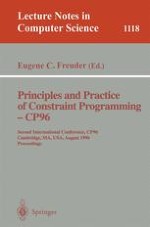1996 | Buch
Principles and Practice of Constraint Programming — CP96
Second International Conference, CP96 Cambridge, MA, USA, August 19–22, 1996 Proceedings
herausgegeben von: Eugene C. Freuder
Verlag: Springer Berlin Heidelberg
Buchreihe : Lecture Notes in Computer Science
Enthalten in: Professional Book Archive
